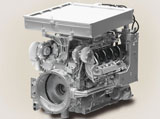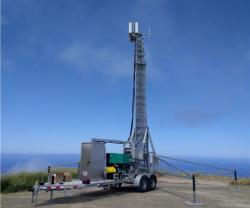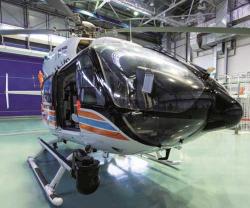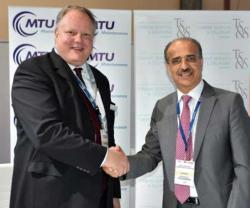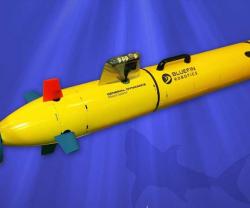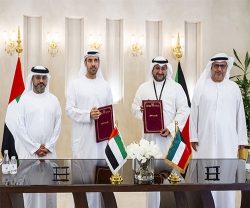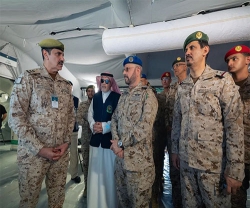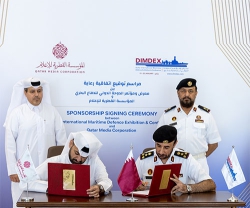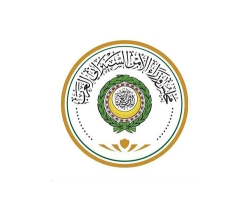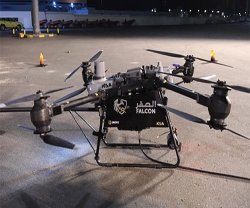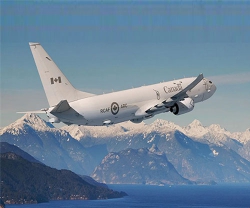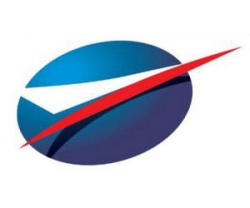MTU at DSEi 2011
06.09.2011 Europe
At DSEi Defense Exhibition (London, 13-16 September), Tognum’s subsidiary MTU will be exhibiting its 8V 199 TE21 engine which will power the Scout and Specialist Vehicles (SV), the British Army’s future generation of armored vehicles, to be built by General Dynamics UK. MTU will be also exhibiting engines and complete drive systems for light, medium and heavy land vehicles as well as naval vessels.
The 8V 199 TE21 engine which will power Scout SV is based on a Mercedes-Benz truck engine and was adapted by MTU to military specifications. In particular, these include increased power as compared with the truck engine (from 480 kW (645 bhp) to 600 kW (805 bhp)) and a torque improvement (3,000 Nm) achieved by harmonizing the turbocharging, injection and electronic control systems. Further features include a 2-stage air-water charge-air cooler, two separate cooling systems (high and low temperature) and a dry sump oil pan.
All of these benefits have been integrated to achieve a solution which combines the technical requirements of military vehicles, such as high power output and compact design for use under extreme conditions, with the economic advantages of the basic commercial unit. Together, the engine and gearbox provide an extremely compact and powerful drive system.
The full load curve was specially optimized for wheeled and tracked vehicles and the engine produces a constant 600 kW (805 bhp) at 2,000 to 2,300 rpm.
The engine is already in service with the infantry fighting vehicles ULAN (Austria) and Pizarro (Spain) as well as the armored personnel carrier Boxer (Germany, Netherlands). General Dynamics will receive the first two prototype engines from MTU before the end of 2011.
MTU will also be showing its 6R 106 and 6V 890 engines as well as a model of the Euro-PowerPack with a MT 883 diesel engine. Each of these engine series sets the standard in its own particular class. In addition, customers can also choose from a range which includes commercial engines, engines adapted for defense applications and engines specially developed for defense applications.
With marine engines in the 4000 Series, MTU is participating in the project “PACSCAT” (Partial Air Cushion Supported CATamaran): a catamaran landing craft with air-cushion support. MTU supplies the main drives for the prototype currently being tested for the British Ministry of Defense.
In the framework of a project, the Ministry is testing various prototypes of landing crafts with a high loading capacity and higher speeds than conventional landing crafts. The PACSCAT, made of aluminum, is 30 meters long, seven meters wide and has a loaded weight of 175 tons. Two MTU engines of type 16V 4000 with an output in each case of 2,720 kW (3,650 bhp) power two hydrojet drives. Two further engines inflate the air cushions, which make the craft even faster. Initial tests in fall 2010 revealed a top speed of almost 40 knots (74 km/h). The Royal Marines also successfully tested the landing craft - with the transport of five amphibious vehicles at the same time, or a 62-ton tank. The PACSCAT was designed and jointly built by the Griffon Hoverwork shipyard and the British defense company Qinetiq.
MTU will present a model of the 20-cylinder Series 8000 marine engine. In each case, 2 of these engines with an output of 9,100 kW (12,200 bhp), will power a total of three 99-meter long corvettes of the Royal Navy of Oman. They will be built by the BAE Systems in Portsmouth. The first vessel is already complete; the second vessel will begin tests at sea this year.
The 8V 199 TE21 engine which will power Scout SV is based on a Mercedes-Benz truck engine and was adapted by MTU to military specifications. In particular, these include increased power as compared with the truck engine (from 480 kW (645 bhp) to 600 kW (805 bhp)) and a torque improvement (3,000 Nm) achieved by harmonizing the turbocharging, injection and electronic control systems. Further features include a 2-stage air-water charge-air cooler, two separate cooling systems (high and low temperature) and a dry sump oil pan.
All of these benefits have been integrated to achieve a solution which combines the technical requirements of military vehicles, such as high power output and compact design for use under extreme conditions, with the economic advantages of the basic commercial unit. Together, the engine and gearbox provide an extremely compact and powerful drive system.
The full load curve was specially optimized for wheeled and tracked vehicles and the engine produces a constant 600 kW (805 bhp) at 2,000 to 2,300 rpm.
The engine is already in service with the infantry fighting vehicles ULAN (Austria) and Pizarro (Spain) as well as the armored personnel carrier Boxer (Germany, Netherlands). General Dynamics will receive the first two prototype engines from MTU before the end of 2011.
MTU will also be showing its 6R 106 and 6V 890 engines as well as a model of the Euro-PowerPack with a MT 883 diesel engine. Each of these engine series sets the standard in its own particular class. In addition, customers can also choose from a range which includes commercial engines, engines adapted for defense applications and engines specially developed for defense applications.
With marine engines in the 4000 Series, MTU is participating in the project “PACSCAT” (Partial Air Cushion Supported CATamaran): a catamaran landing craft with air-cushion support. MTU supplies the main drives for the prototype currently being tested for the British Ministry of Defense.
In the framework of a project, the Ministry is testing various prototypes of landing crafts with a high loading capacity and higher speeds than conventional landing crafts. The PACSCAT, made of aluminum, is 30 meters long, seven meters wide and has a loaded weight of 175 tons. Two MTU engines of type 16V 4000 with an output in each case of 2,720 kW (3,650 bhp) power two hydrojet drives. Two further engines inflate the air cushions, which make the craft even faster. Initial tests in fall 2010 revealed a top speed of almost 40 knots (74 km/h). The Royal Marines also successfully tested the landing craft - with the transport of five amphibious vehicles at the same time, or a 62-ton tank. The PACSCAT was designed and jointly built by the Griffon Hoverwork shipyard and the British defense company Qinetiq.
MTU will present a model of the 20-cylinder Series 8000 marine engine. In each case, 2 of these engines with an output of 9,100 kW (12,200 bhp), will power a total of three 99-meter long corvettes of the Royal Navy of Oman. They will be built by the BAE Systems in Portsmouth. The first vessel is already complete; the second vessel will begin tests at sea this year.
Previous PostCassidian Receives German AF's Eurofighter Contract
Latest news
Latest events
Paris Air Show
16 - 22 Jun 2025Paris Le Bourget - FranceDefenPol China2025 - 7th Guangzhou International Defense & Police Exhibition & Summit
11 - 12 Jul 2025Nan Fung International Convention & Exhibition Center (NICEC) - ChinaIDEF 2025 Turkey - International Defence Industry Fair
22 - 27 Jul 2025Istanbul Expo Center - TurkeyDSEI 2025
09 - 12 Sep 2025Excel, London - United Kingdom

